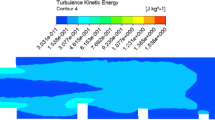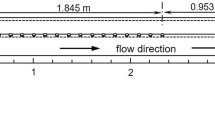Abstract
Mixing layers and associated large-scale turbulent structures are some of the most common features of turbulent shallow water flow. Due to their quasi-two-dimensional nature, large-scale structures are also referred to as two-dimensional coherent structures (2DCS). The presence of these structures instigates several complications in the flow, such as scouring of the bed material, affecting the maneuverability of water vessels, and causing the formation of pollutant trapping zones inside recirculating flows; thus, impacting the stability of hydraulic structures, inducing drowning hazards, and affecting aquatic environments in the vicinity. Like all turbulence phenomena, it is challenging to predict shallow water turbulence directly with sufficient accuracy due to its highly random nature. This work proposes a semi-coupled model that aims to predict the spatial distribution of 2DCS in an open channel flow domain. The proposed model solves the 2D unsteady full momentum equations, and the computed outputs are analyzed to predict the possible locations of 2DCS in the flow. The model parameters are calibrated with experimental observations. The model results are then compared with CFD simulations of the Shallow Water model and standard turbulence models (k-Ɛ, k-ω, and LES (Large Eddy Simulation)), performed in OpenFOAM. A good agreement is observed between the results. The proposed model is approximately five times faster in predicting large-scale turbulent structures than standard CFD simulations. Results also demonstrate the superiority of LES models in resolving large-scale turbulence.

Source: Google Earth)

















Similar content being viewed by others
Availability of data and material
The codes were developed in MATLAB and Python, and the output data can be provided on request.
Code availability
The codes can be provided on request.
References
Alavian V, Chu VH (1985).Turbulent exchange flow in shallow compound channel. In: Proceedings of the 21st international congress of IAHR, pp 446–451
Babarutsi S, Chu VH (1998) Modeling transverse mixing layer in shallow open-channel flows. J Hydraul Eng 124(7):718–727
Baruah A, Sarma AK (2020) Ecological flow assessment using hydrological and hydrodynamic routing model in Bhogdoiriver, India. Modeling Earth Syst Environ 1:1–10
Batchelor CK, Batchelor GK (2000) An introduction to fluid dynamics. Cambridge University Press
Chen D, Jirka GH (1995) Experimental study of plane turbulent wakes in a shallow water layer. Fluid Dyn Res 16(1):11
Chu VH (1983) Stability of turbulent shear flows in shallow channel. Proc XX Congress IAHR, Moscow, 3:128–133
Chu VH, Babarutsi S (1988) Confinement and bed-friction effects in shallow turbulent mixing layers. J Hydraul Eng 114(10):1257–1274
Daoyi C, Jirka GH (1998) Linear stability analysis of turbulent mixing layers and jets in shallow water layers. J Hydraul Res 36(5):815–830
Han L, Mignot E, Riviere N (2017) Shallow mixing layer downstream from a sudden expansion. J Hydraul Eng 143(5):4016105
Han L, Riviere N, Chatelain M, Mignot E (2020) Recirculation zone downstream lateral expansions of open channel flow. Phys Fluids 32(11):1119
Ingram RG, Chu VH (1987) Flow around islands in Rupert Bay: an investigation of the bottom friction effect. J Geophys Res: Oceans 92(C13):14521–14533
Jirka GH (2001) Large scale flow structures and mixing processes in shallow flows. J Hydraul Res 39(6):567–573
Jirka GH, Uijttewaal WSJ (2004) Shallow Flows: Research Presented at the International Symposium on Shallow Flows, Delft, Netherlands, 2003. Taylor and Francis
Lam MY (2015) The development of shallow mixing layers: the roll-up and merging of large scale coherent structures
Nassiri M, Babarutsi S, Chu VH (1999) Wall boundary conditions on recirculating flows dominated by bottom friction. Proceedings of XXVIII IAHR Congress
Pope SB (2001) Turbulent flows. IOP Publishing
Sohankar A, Norberg C, Davidson L (1999) Simulation of three-dimensional flow around a square cylinder at moderate Reynolds numbers. Phys Fluids 11(2):288–306
Spalding DB (1974) The numerical computation of turbulent flow. Comp Methods Appl Mech Eng 3:269
Talstra H (2011) Large-scale turbulence structures in shallow separating flows
Uijttewaal WSJ, Booij R (2000) Effects of shallowness on the development of free-surface mixing layers. Phys Fluids 12(2):392–402
Uijttewaal WSJ, Tukker J (1998) Development of quasi two-dimensional structures in a shallow free-surface mixing layer. Exp Fluids 24(3):192–200
van Prooijen BC, Uijttewaal WSJ (2002) A linear approach for the evolution of coherent structures in shallow mixing layers. Phys Fluids 14(12):4105–4114
. Wikipedia contributors (2021) Large eddy simulation. In: Wikipedia, The Free Encyclopedia. https://en.wikipedia.org/w/index.php?title=Large_eddy_simulation&oldid=1033178244
Wilcox DC, et al (1998) Turbulence modeling for CFD (Vol. 2). DCW industries La Canada, CA
Winant CD, Browand FK (1974) Vortex pairing: the mechanism of turbulent mixing-layer growth at moderate Reynolds number. J Fluid Mech 63(2):237–255
Author information
Authors and Affiliations
Contributions
All authors contributed to the study's conception and design. Material preparation, data collection, and analysis were performed by [B.K.], and [A.H.]. The first draft of the manuscript was written by [B.K., A.B.] and supervised by [A.K.S.]. All authors read and approved the final manuscript.
Corresponding author
Additional information
Publisher's Note
Springer Nature remains neutral with regard to jurisdictional claims in published maps and institutional affiliations.
Rights and permissions
About this article
Cite this article
Kalita, B., Baruah, A.J., Handique, A. et al. A semi-coupled model for determining the distribution of two-dimensional coherent structures in open channel flow. Environ Fluid Mech 22, 743–761 (2022). https://doi.org/10.1007/s10652-022-09847-4
Received:
Accepted:
Published:
Issue Date:
DOI: https://doi.org/10.1007/s10652-022-09847-4




